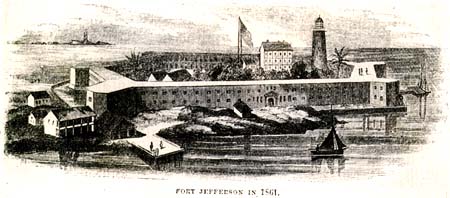The Calvin Shedd Papers > Background > Fort Jefferson
Fort Jefferson
| Date(s) of Letter(s) | Fort Jefferson
and its Commander 1861-2. Reprinted from Journal Military Service Institution.
New York: Governor's Island, 1910. Schmidt, Lewis G. The Civil War in Florida: A Military History. Vol III: Florida's Key's & Fevers. Allentown, Pennsylvania: L. G. Schmidt, 1989.
|
| March 2, 1862 |
Fort Jefferson is
located in the Dry Tortugas, about seventy miles west of Key West in the Gulf of Mexico.
During the Civil War, seven islands and a series of coral reefs made up the Dry
Tortugas. The fort is situated on Garden Key, sixteen acres in size, almost
completely covering the island. The first construction on the key was a lighthouse,
built on the present site of the fort in 1825. Construction for the fort, named for
President Thomas Jefferson, began in 1846. The walls were fifty feet high and eight
feet thick and enclosed two tiers, with a third level of gun emplacements on the top of
the walls. The fort housed 450 guns and 1500 troops. The structure is
considered to be the largest masonry fort in the western hemisphere. Soldiers
acquired fresh water by channeling rain water into cisterns located beneath the
fort. Problems with dirt and the settling of the fort caused the water in these
cisterns to be impure. Disposing of garbage into the moat and the poor operation of
the tide-flushed toilet facilities caused other health problems. Most of the quarters for the garrison during the Civil War were wooden sheds and tents inside the parade ground. The fort had its own post office and letters mailed out were marked with a postal mark made by a circular hand stamp. Union forces seized Fort Jefferson in January, 1861, with Major L. G. Arnold in command. Harper's Weekly published a description of the fort and its new commander in February, 1861. During the early years of the war, the fort was used as a supply depot for the distribution of rations and munitions to Federal troops in the Mississippi Delta and as a supply and fueling station for the naval forces engaged in the blockade of the Confederacy. The fort also served as a Federal prison. Fort Jefferson was in a continuous state of construction and modification for thirty years, but was eventually rendered obsolete before completion. The fort is now a National Park and is visited by seaplane or private boat. |

|
|
